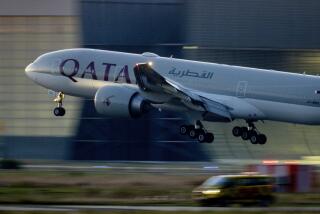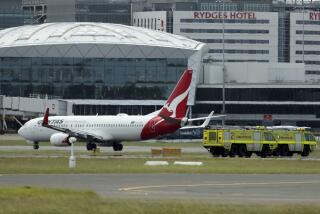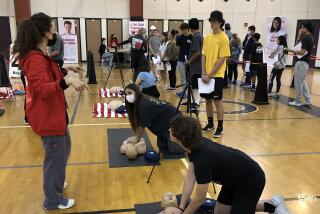Qantas Leap: Averting In-Flight Cardiac Deaths
- Share via
Winnie McKeown of Birmingham, England, is a shining example of Qantas Airways’ defibrillator program. She is living proof that the Australian carrier’s decision to stock long-haul flights with defibrillators--briefcase-size devices to restore normal heart rhythm via electrical shock--is helping to prevent cardiac-related deaths aloft.
On a London-bound flight nearly three years ago, McKeown was successfully defibrillated on board, then rushed to a London hospital. Recently she was joined in celebrating her 82nd birthday by Peter Engeler, the Qantas flight service director who administered the shocks.
Since Qantas first put defibrillators aboard all 53 of its international Boeing 747 and 767 aircraft and placed them throughout Qantas airport terminals five years ago, 23 people have had their heart rhythm restored before transfer to hospitals, according to a report on the program released last month at the American College of Cardiology annual meeting in Anaheim. Of those patients, six were long-term survivors.
“A lot of airlines are going to follow suit,” predicted Dr. Eric Donaldson, general manager of Qantas’ aviation health services, who presented the findings with Dr. Michael O’Rourke of St. Vincent’s Hospital, Sydney, a collaborator on the study.
A random polling of airlines suggests he is correct.
This month, American Airlines becomes the first U.S. airline to put defibrillators on board. By early summer, 285 aircraft making international flights are expected to be equipped with the battery-operated devices, said spokesman John Hotard. “We are training 2,300 flight attendants and pursers,” he added.
By the end of the year, Cathay Pacific Airways plans to stock defibrillators on all 60 of its aircraft, said spokeswoman Diana Fung.
Like Qantas, some foreign carriers have stocked the devices for several years. Air Zimbabwe began to stock its London- and Frankfurt-bound flights with defibrillators seven years ago, according to Sam Kordi, a spokesman. Virgin Atlantic Airways launched a defibrillator program in 1990.
Meanwhile, other airlines will wait and see. “We’re reviewing the issue,” said James Boyd, spokesman for Air New Zealand. Other airline spokespersons echoed that statement.
The issue is also being studied by the Air Transport Assn., a Washington, D.C.-based industry group that represents major U.S. carriers, said David Fuscus, a spokesman.
Some argue that in-flight deaths are not common and wonder if the expense of defibrillators is justified. (Qantas officials said they paid about $10,000 per unit. Today, the units, known as automatic external defibrillators or AEDs, cost about $3,000.)
Every year, there are about 72 deaths aboard aircraft, according to a study of 120 airlines conducted from 1977 to 1984 and published in the Journal of the American Medical Assn. in 1988. About 63% of the deaths were due to sudden, unexpected cardiac problems, and the most likely victims were middle-age men.
Landing the aircraft as soon as possible and getting an ambulance quickly is another option. “More often not, the passenger is in the hands of the medical profession more quickly than if [he or she had been stricken] on the ground,” said Fuscus of the ATA, basing the statement on conversations he has had with airlines. But he did not have a specific figure on the average time required for an aircraft to divert its course and get a passenger to medical care on the ground.
But Donaldson of Qantas did have a figure. Based on his airlines’ experience, diverting an aircraft from cruising altitude takes at least 20 minutes, he said. And that can be detrimental to the patient, he added. In the wake of a cardiac event, the faster medical help is obtained, the better, according to the American Heart Assn. “Defibrillation success generally decreases by 10% per minute,” said an AHA spokeswoman.
In years past, said the ATA’s Fuscus, there was concern that the person operating the defibrillator might not be adequately skilled and that, “You could do more harm than good. [But] that’s changed as technology has changed.”
“The flight attendant does not have to do any diagnosing,” said David Stiehr of Heartstream Inc. in Seattle, the manufacturer of the defibrillator model bought by American, called the ForeRunner. “The software makes the defibrillator decision,” he said. “The flight attendant applies the pads for the electrocardiogram and the software automatically reads it.”
The Healthy Traveler appears the second and fourth week each month.
More to Read
Sign up for Essential California
The most important California stories and recommendations in your inbox every morning.
You may occasionally receive promotional content from the Los Angeles Times.










